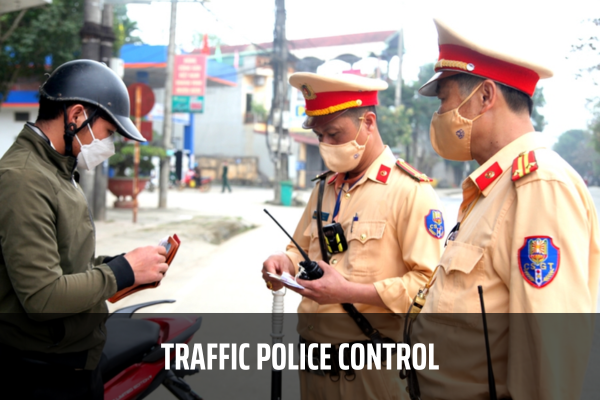Vietnam: In the case where the traffic violator does not sign or make a mark on the record, how many witnesses are required at minimum to sign and confirm the non-signing or marking of the violator?
- Vietnam: In the case where the traffic violator does not sign or make a mark on the record, how many witnesses are required at minimum to sign and confirm the non-signing or marking of the violator?
- When will Vietnamese traffic police officers be authorized to stop vehicles?
- Vietnam: What is the process of traffic police control?
Vietnam: In the case where the traffic violator does not sign or make a mark on the record, how many witnesses are required at minimum to sign and confirm the non-signing or marking of the violator?
Pursuant to clause 2 of Article 20 of Circular 32/2023/TT-BCA, there are regulations on handling violations during patrols and inspections as follows:
Handling violations during patrols and inspections
The handling of administrative violations shall be carried out in accordance with the provisions of the law on handling administrative violations and the following regulations:
...
2. Imposing administrative fines with the drafting of a record
...
c) In cases where the violator is not present at the scene of the violation or deliberately evades, or for objective reasons cannot sign or make a mark on the record, or in cases where the identity of the violator cannot be determined, the Head of the Traffic Police Team shall invite a representative of the commune-level authorities where the violation occurred or at least one witness to sign and confirm the non-signing or marking of the violator on the record; if there is no signature of the representative of the commune-level authorities or the witness, the traffic police officer must clearly state the reason in the record. The use of technical equipment and devices in the professional field to record the incident and a written report to the unit leader shall be made as a basis for the competent authority to review and decide on the penalty.
...
Therefore, if the violator does not sign or make a mark on the record, it is sufficient to have at least one witness sign and confirm the non-signing or marking of the violator on the record, or to invite a representative of the commune-level authorities where the violation occurred to sign the confirmation.
If there is no signature of the representative of the commune-level authorities or the witness, the Vietnamese traffic police officer must clearly state the reason in the record.

Vietnam: In the case where the traffic violator does not sign or make a mark on the record, how many witnesses are required at minimum to sign and confirm the non-signing or marking of the violator?
When will Vietnamese traffic police officers be authorized to stop vehicles?
Pursuant to Clause 1, Article 16 of Circular 32/2023/TT-BCA, Vietnamese traffic police officers are authorized to stop vehicles for control in the following 04 cases:
- Directly detecting or through technical devices detecting and collecting evidence of violations of road traffic laws and other legal violations.
- Carrying out orders and plans for overall vehicle control to ensure road traffic order and safety, social order; implementing plans for patrols, control, and handling of violations according to the authorized issued topics.
- Having written requests from the head or deputy head of the investigating agency; written requests from relevant functional agencies to stop vehicles for control in order to serve the work of ensuring security, order; fighting against crimes; preventing and combating natural disasters, fires, epidemics; rescue operations, and other legal violations.
- Receiving reports, feedback, suggestions, or denunciations from organizations or individuals regarding violations of the law by individuals or vehicles participating in road traffic.
Vietnam: What is the process of traffic police control?
Pursuant to the regulations in Article 18 of Circular 32/2023/TT-BCA regarding the process of traffic police control, it is conducted in the following steps:
Step 1: Request the vehicle operator to take safety measures and stop the vehicle.
Step 2: Greet the person according to the regulations of the People's Police (except in cases where there is prior knowledge that the person has committed criminal acts, is caught in the act of committing an offense, or is under arrest warrant). When interacting with individuals who have violated the law, traffic police officers must maintain the correct posture, decorum, attitude, and behavior.
Step 3: Notify the vehicle operator and the individuals on the vehicle of the reason for the control; request the vehicle operator to present relevant documents or information of the relevant documents in the electronic identification account.
Step 4: Perform control measures as stated in Clause 2 of Article 12 of Circular 32/2023/TT-BCA:
- Control documents related to individuals and vehicles.
- Control the conditions for participating in traffic of the vehicles.
- Control compliance with regulations on road transport safety.
- Control other relevant contents as prescribed by law.
For vehicles carrying 10 or more passengers, or vehicles with dimensions equivalent to those carrying 10 or more passengers, the control must be conducted directly inside the passenger compartment, and the control results must be communicated to the vehicle operator.
Step 5: Conclude the control process.
The traffic police officer reports the control results to the team leader, informs the vehicle operator and the individuals on the vehicle about the control results, any violations (if any), and the measures to be taken.
* Note:
- If there is reasonable ground to believe that a person, vehicle, or object involved in traffic has hidden evidence, vehicles, or documents used for administrative violations, they can be searched according to the provisions of the law on handling administrative violations.
- In the case of detecting signs of criminal offenses, the procedures prescribed by the law on criminal proceedings shall be followed.
LawNet
